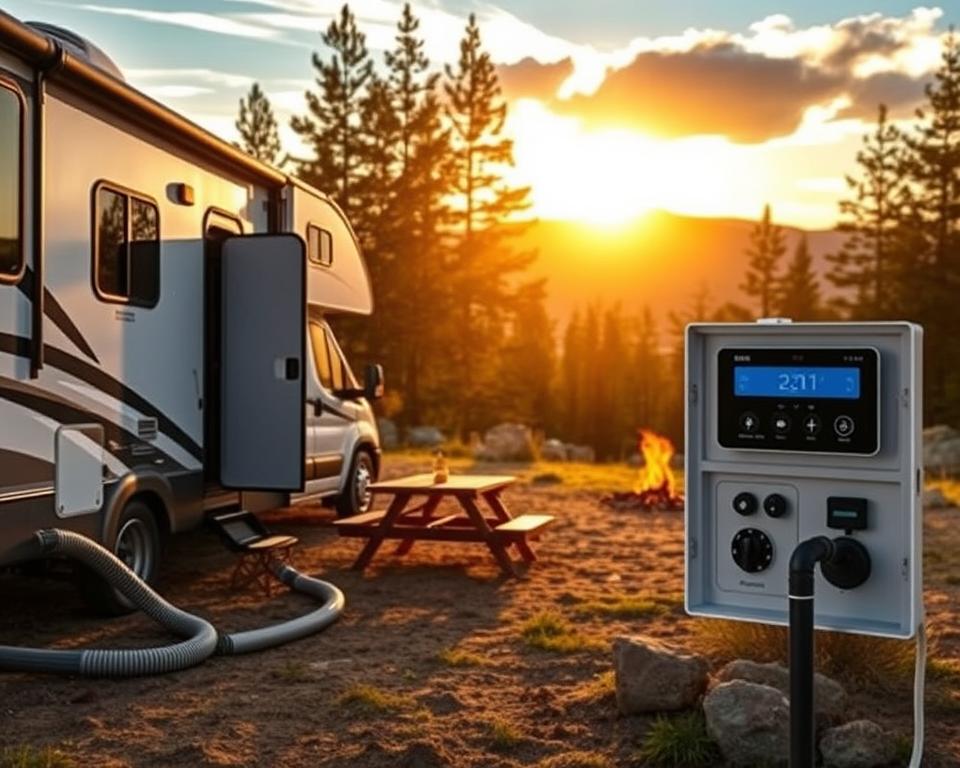Camper Waste Pump Manual: Optimized Dumping Approaches
Ever thought about how critical proper waste disposal is while traveling in your motorhome? Many enthusiasts feel waste disposal dampens their fun. The need to locate a suitable dumping station and the complexities of wastewater handling can affect your road trip. Yet, a trustworthy RV waste pump provides the efficiency you need for trouble-free emptying. This guide emphasizes the significance of RV sewage pumps in transforming your waste management. It ensures cleanliness, improving your RV journey.
Major Highlights
- Effective waste management is crucial for RV owners.
- Trustworthy macerator units can improve dumping routines.
- Mobile sewage pumps enhance convenience during RV adventures.
- Grasping wastewater tank care is key for RV sanitation.
- Efficient disposal solutions enhance overall travel quality.
Getting to Know RV Waste Systems
Maintaining hygiene and comfort in your travels requires proper RV waste management. A good setup includes a toilet sewage tank for human waste. It also comprises other elements crucial for sanitation. Knowing how these components work is important for safe and efficient waste disposal.
Camper-generated waste is distinct from household wastewater. This reality highlights the importance of specialized waste management. Trippers need to learn on caring for their sewage reservoir. Proper care sidesteps odors and clogs, which can impede your trip.
Securing disposal points is key, especially in off-grid locations. While many sites provide proper facilities, they aren’t always accessible. Thus, planning disposal ahead is beneficial. This preparation can considerably boost your camping experience.
Ultimately, handling camper waste properly requires knowing your RV’s waste system and preparing for disposal. Being knowledgeable guarantees a better adventure in your RV.
Understanding Waste Pumps
A motorhome disposal pump is essential for emptying black water tanks from RVs. The camper grinder unit pulverizes solid waste into thin sludge. This permits simple transfer through a standard hose to a disposal site. It’s especially advantageous when gravity-fed systems fail.
Traditional sewage pumps and grinder units contrast in mechanism. Macerator pumps shred waste, making disposal simpler. This makes disposal easier in difficult locations.
All users need to grasp how an RV waste pump works. Using a macerator pump enhances pumping, also simplifies emptying in remote areas. Proper use keeps the disposal system efficient, improving your RV adventures.
Mechanics of a Macerator Pump
An RV macerator pump employs premium cutting elements that shred waste into a thin fluid mixture, reminiscent of a household disposer. This efficiency is essential for waste management in RVs. By liquefying waste, the pump allows sewage to be pushed through lengthy hoses. It also helps in transporting uphill, warding off clog risks.
Each time the toilet is flushed, the RV macerator pump’s blades are activated. This automatic activation ensures a smooth waste processing. It simplifies the disposal process, especially when emptying into septic tanks. Thus, RV owners are reassured of a dependable disposal network.

Advantages of Camper Pumps
An RV waste pump delivers key advantages in efficient waste disposal, improving waste management for RV enthusiasts. A major perk is the elevation of cleanliness. This device optimizes disposal, substantially minimizing contamination risks.
Using a macerator means managing sewage with ease, even in off-grid sites. This removes the need for traditional, bulky disposal methods. The comfort it offers ensures peace of mind while traveling. It grants quick hookups or portable dump stations, at campsites or en route.
Moreover, these pumps are designed to combat foul smells. Many feature anti-odor tech. This creates a more hygienic environment inside your RV, making camping better.
Their compact size means they fit easily, allowing storage. Investing in an RV waste pump is a wise decision for improving travel comfort.
Pump Uses Beyond RVs
Camper sewage grinders are not exclusive to recreational vehicles. They are crucial for proper sewage handling in various environments. This includes yachts, tiny homes, and even job locations. They cater to varied tasks, fitting to lifestyles and disposal requirements.
For those camping in remote areas, RV waste pumps are essential. They streamline remote emptying. Travelers can then relish adventures, free from dump station hunts. It’s a critical component for anyone passionate about RV camping.
In the micro-living scene, these pumps are game-changers. Space is a luxury, and maintaining hygiene is paramount. RV waste pumps address both, managing waste without taking up too much room. They blend smoothly into compact layouts.
Job sites see a lot of waste. RV waste pumps present a remedy to this problem. They prevent mess, and comply with codes. Their ability to handle tough waste materials makes them vital for construction projects.
This versatility underscores their importance in effective waste management. They are essential across various contexts, from RVs and tiny homes to construction sites. Their reliability in boosting convenience is unmatched.
Choosing the Best RV Waste Pump for Your Needs
Picking the ideal macerator pump requires several important factors. Analyzing the pump’s capacity, build quality, and fit for your RV’s size is crucial. It’s important to pick a pump that can support how often you’ll use it.
Key factors to consider include:
- Usage rate: Evaluate how often you’ll need the pump to handle effluent adequately.
- Route type: Consider the types of campsites you’ll encounter. Some pumps manage elevation changes with ease.
- Setup convenience: Look for models that are hassle-free to set up, so you can start using them without fuss.
- Disposal needs: Assess the type of waste and fluid you’ll be pumping to confirm pump compatibility.
Take care in analyzing these elements. This provides you make a sound decision. Selecting the best RV waste pump will greatly enhance your RV experience.
Popular RV Waste Pumps on the Market
Selecting a top RV waste pump can drastically enhance your RV lifestyle. Leading models include the Shurflo Macerator 8000. They boast functions that satisfy diverse requirements within the RV community.
The SeberFlo pump is praised for its rapid action and intuitive design. It delivers a high flow rate that efficiently purges reservoirs. Its trustworthiness and space-saving form make it a popular choice for those valuing speed.
The Flojet grinder is renowned among solid waste processors. It is engineered for range, handling varied sewage tasks with ease. Its robust framework and accessible features confirm its appeal for durability and efficiency enthusiasts.
| Feature | SewerFlo Quick Release | Flojet 18555-000A |
|---|---|---|
| Flow Rate | 30 GPM | 13 GPM |
| Weight | 8 lbs | 6 lbs |
| Portability | High | Medium |
| Durability | Moderate | High |
Reviews of these RV pumps highlight their unique strengths that shape preferences. Simplicity and performance are key, steering users in their selections. Whether it’s the Flojet, noting their differences ensures you find the right waste pump.
How to Install and Care for Camper Pumps
Proper setup of your RV waste pump is key. It provides a reliable join to the RV’s waste system, avoiding spills and maximizing efficiency. First pick an best area near the waste tank. This minimizes hose runs, improving flow. Secure the pump firmly, per the manufacturer’s guidelines for flawless operation.
To install your RV waste pump effectively, follow these tips:
- Assemble required parts and tools.
- Before starting, shut down the system and drain the reservoir.
- Position the pump in an well-ventilated, reachable location.
- Connect the outlet tube to the pump and route it to the dump site.
- Tighten all fittings before powering up the pump.
Effective upkeep significantly lengthens your pump’s lifespan. Here are critical care steps:
- Review for damage or wear each month.
- Employ recommended cleaning agents to stop clogs.
- Cycle the unit occasionally in downtime to preserve seal lubrication.
- Remove clutter near the unit.
Should you run into snags like reduced flow, try these troubleshooting steps:
- Check tubing for blockages.
- Verify pump has power and fittings are tight.
- Consult the owner’s manual for model-specific fixes.
Beyond Pumps: Disposal Alternatives
Camper enthusiasts need to manage waste efficiently for a smooth camping experience. Fixed disposal points are often out of reach in remote spots. Thus, exploring alternative methods is wise. A campground pump-out service allows on-site tank emptying, boosting convenience.
Additional solutions include dry toilets and portable waste containers. Composting toilets use minimal water and convert waste into compost. Portable containers offer easy transport to disposal sites as needed.
Choosing appropriately depends on personal preference. By evaluating these options, RVers can maintain hygiene while exploring.
The Bottom Line
Proper camper sewage handling is key for a tidy living space on the move. We’ve explored different macerators, their functions, and benefits. A quality pump revolutionizes travel by ensuring swift disposal.
Opting for this brand’s model streamlines dumping and boosts enjoyment. With suitable tools, RVers can travel worry-free, without dumping hassles, creating a better experience for all.
Maintaining cleanliness underscores the need for efficient disposal, improving travel experiences and ensuring a safe, enjoyable environment.


